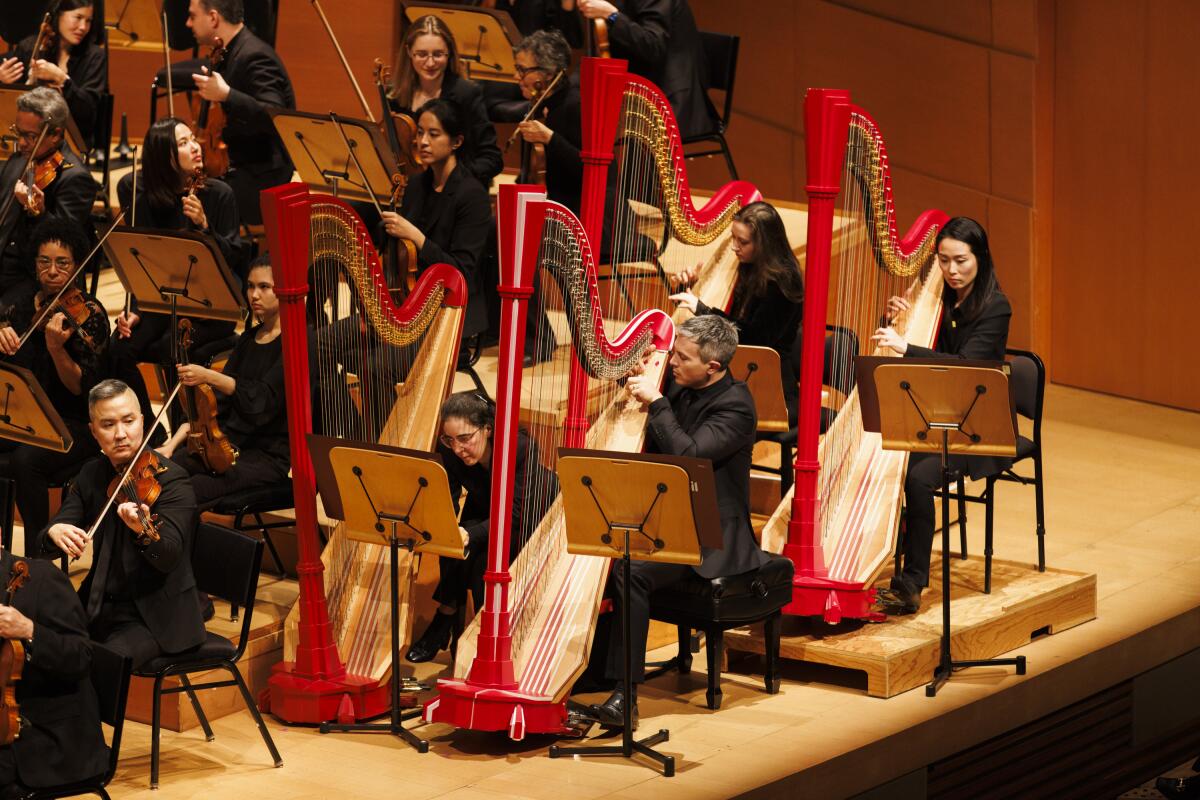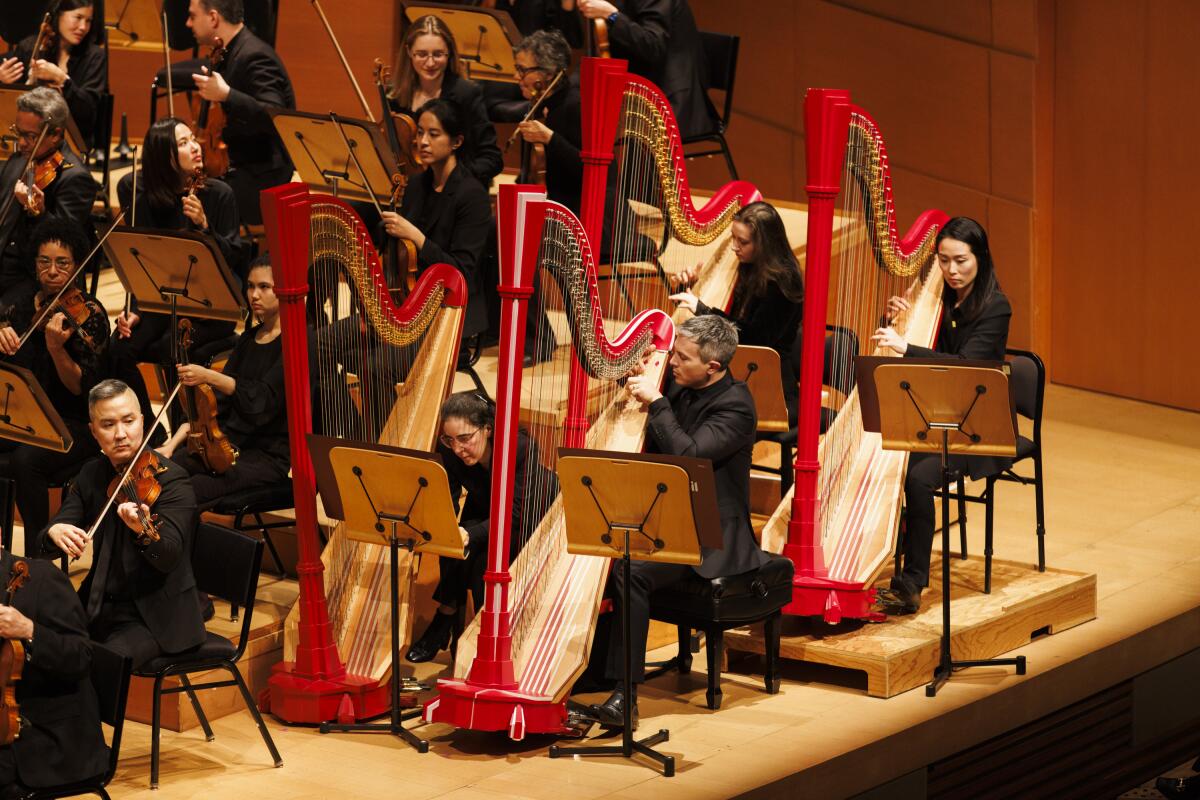It would be hard to come up with a more radically divisive major composer than Arnold Schoenberg, who was born in Vienna in 1874 and died in Los Angeles in 1951. It would be equally hard to come up with a more radically inclusive composer, who remade European music in his image and then came here and did the same for Hollywood. Or a more devotedly progressive — you could even say obsessively progressive — composer who honored the past yet paved the way for a kicking-and-screaming future.
We still don’t quite know how to sell Schoenberg. There is the scary modernist Schoenberg — inventor of the 12-tone system, replacing traditional harmony with the democratic notion that all notes are equal — who reputedly drives audiences away. But there is also the Schoenberg who carried on from the 19th century Romantic tradition in his lush early scores like the massive post-Wagnerian and post-Brahmsian “Gurrelieder.”
The big event ending this year’s celebration of the 150th anniversary of Schoenberg’s birth was Zubin Mehta conducting the grandiose “Gurrelieder” over the weekend with a huge Los Angeles Philharmonic (replete with four red harps), the Los Angeles Master Chorale and big-throated vocal soloists.
“Gurrelieder” is the first sign of the real Schoenberg, whose music, no matter how thorny or how esoteric, always embraced the big picture relating the past to the future. Devoted to the contrapuntal wonders of Bach, the classicism of Mozart and the astonishment of Beethoven, Schoenberg began his career by mending the major divide of his own early years, that of Wagner the futurist and Brahms the keeper of tradition.
In Brahms, Schoenberg found progressivist harmonic thinking that was logically heading toward atonality. Once when recognized by a stranger who asked him if he was the composer Arnold Schoenberg, he replied, “Someone has to be.” From Wagner, Schoenberg got the bug for endless thematic development, from one thing leading to the next and the next in the path toward rapture.
In no work does Schoenberg embrace the spirits of Brahms and Wagner more radiantly than in a “Gurrelieder.” Over a luxurious two hours, this quasi-oratorio is a big fat glorious mess, and no conductor loves it more than Mehta. At 88, Mehta is the dean of Schoenberg conductors. When he became music director of the L.A. in 1962, at the age of 26, he told the press that he felt it more important in L.A. to conduct all the neglected orchestra works of Schoenberg before doing all the Beethoven symphonies.
By the late 1960s he was well into his Schoenberg advocacy. He conducted the first L.A. Phil performance of “Gurrelieder” in 1968 in the Dorothy Chandler Pavilion, around the same time he was making sonic-spectacular recordings of early and late Schoenberg, catnip to audiophiles that impress to this day, with the orchestra in Royce Hall at UCLA. That’s also where Schoenberg happened to have taught students who went on to become Hollywood film composers, experimentalists or both. David Raksin (composer of “Laura”) and John Cage said they worshiped Schoenberg like a god.
Mehta had last conducted “Gurrelieder” with the L.A. Phil in 1977, his penultimate season as music director. He concluded his 13-year tenure as music director of the New York Philharmonic with “Gurrelieder” in 1991 and recorded it. Two decades later, Mehta recorded “Gurrelieder” again, this time with the one other orchestra of which he has been music director, the Israel Philharmonic.
Meanwhile “Gurrelieder” has proved a favorite for three of Mehta’s successors at the L.A. Phil. André Previn was supposed to conduct it in 1991 but took ill and was replaced by Gerard Schwarz. Esa-Pekka Salonen led a dazzling “Gurrelieder” in Disney Hall in 2005. Gustavo Dudamel had hoped to conduct his first “Gurrelieder” in 2020; that was canceled because of COVID.
Mehta’s “Gurrelieder” has, with age, naturally grown less flamboyant and more reflective. He connected it with Brahms by conducting Brahms’ Violin Concerto (with soloist Leonidas Kavakos) and Second Symphony the week before. He marshaled the large forces of “Gurrelieder” seated on the podium.

The L.A. Phil performs Schoenberg’s gargantuan “Gurrelieder,” at Walt Disney Concert Hall
(Carlin Stiehl/For the Times)
Though not as demonstrative as he once was, Mehta has not lost the essence of his L.A. Phil sound. There it was, big and bold, from the first firm notes of Brahms’ concerto to the searing, earth-shattering sunrise grandeur of the finale of “Gurrelieder.”
It’s a crazy work, begun in 1900 in an attempt to out-Wagner Wagner but not completed for 11 years, during which time Schoenberg had moved toward atonality and modernism. A king, Waldemar, in an unhappy marriage, has an affair with a lover, “Tove.” She dies. He can no longer face life without her. He dies, and in the afterlife he is forced to hunt all day. It gets weirder and more surreal with a narrator for the ending.
As a very last-minute replacement for tenor Brandon Jovanovich, who caught one of those viruses floating around L.A., John Matthew Myers proved an impressive quick study as a sturdy Waldemar. Christine Goerke as Tove and Violeta Urmana as a prescient Wood Dove, though not always steady, brought Wagnerian robustness in the other two major roles. There was more character to Gabriel Manro’s peasant and particularly Gerhard Siegel’s fool. Dietrich Henschel was a more melodic narrator than most.
But the glory goes to the orchestra and Los Angeles Master Chorale, which appeared to give Mehta all he asked for and maybe more. In the end, Mehta let “Gurrelieder” speak for itself in a very loud voice.
That’s one way of making the Schoenberg case. There are others. Schoenberg hangs over L.A. more than we often realize. Four days before “Gurrelieder,” Piano Spheres, which was founded by pianist and Schoenberg assistant Leonard Stein 30 years ago, opened a tribute program remembering pianist Susan Svrcek and composer Frederick Lesemann with Webern’s eight-hand arrangement for four pianists at two pianos of the opening of “Gurrelieder.” It enticingly glittered as much as a four-harped orchestra.
In February, the Jacaranda new music series, shutting down after two decades of indispensable concerts, went out with a Schoenbergian bang, connecting the composer to Hollywood, Mahler, Coltrane and Boulez. But perhaps the most intriguing connecting of Schoenberg to Hollywood will be the West Coast premiere of Tod Machover’s opera “Schoenberg in Hollywood,” which UCLA will mount in a new production at the Nimoy in May — and, of course, will rehearse in UCLA’s Schoenberg Hall.
